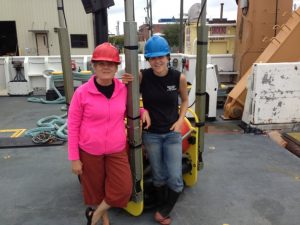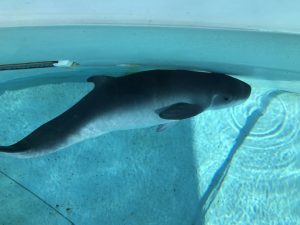Study Tracks Elusive Whales with Acoustic Data Collected During Oil Spill Research
– MARCH 25, 2020
Scientists who monitored large marine mammals with Passive Acoustic Monitoring (PAM) technology during and following Deepwater Horizon were able to estimate population densities for the cryptic pygmy sperm and dwarf sperm whales (Kogia species). These deep-diving whales (400 – 1000m) are difficult to observe because they show only a faint, low profile during their brief time at the water’s surface. Using acoustic methods, the team’s estimated population densities for these whales is substantially higher (4–16 animals/1000 km2) than those derived from line transect visual surveys (0.5 animals/1000 km2). The data also suggest an increasing interannual density trend within the oil spill’s primary impact zone and to the southeast of the spill site. The researchers captured a rare glimpse into these whales’ presence and behavior in the Gulf of Mexico and demonstrated a new tool that can inform conservation management of elusive cetacean populations.
The authors published their study in Frontiers in Marine Science: Assessing seasonality and density from Passive Acoustic Monitoring of signals presumed to be from Pygmy and Dwarf Sperm Whales in the Gulf of Mexico.
“Pygmy and dwarf sperm whales are known to inhabit the Gulf of Mexico because they appear as stranded animals on the beach,” explained study author John Hildebrand of the Scripps Institution of Oceanography. “But they are incredibly difficult to spot at sea because they spend so much time submerged and conduct deep dives when foraging.”
Hildebrand said that the ability to continuously record sound at high frequency and for long time periods was critical to the study’s success. The team deployed High-frequency Acoustic Recording Packages (HARPs), which recorded continuously at 200 kHz for 2-9-months during 2010–2013 at five sites: two shallow water sites (Main Pass 86m and DeSoto Canyon 268m) and three deep water sites (Mississippi Canyon at 980 m, Green Canyon at 1100m, and Dry Tortugas at 1300m). The HARP instrumentation package was located at or near the seafloor with a tethered hydrophone sensor that buoyed approximately 10 m above the seafloor.
Using the MATLAB (Mathworks) based custom software program Triton and other MATLAB custom routines, the team characterized high-frequency echolocation clicks. They realized that the data yielded ample detections of high-frequency echolocation clicks most likely from the two Kogia species.
“The density of pygmy and dwarf sperm whales that we detected acoustically is much higher than what had been estimated based on visual sighting data, but more in-line with what would be expected given the large number of animals that are found to strand on Gulf of Mexico beaches,” explained Hildebrand.
The study said that the overall increases at the deep-water sites may be the result of animals moving into those areas following large temporal scale oceanographic cycles and/or habitat recovery after the oil spill. The relative low densities at the Mississippi Canyon site in the summer and fall of 2010 suggest the possibility that the whales avoided those areas because of the oil’s presence and the many response vessels in the area.
“Pygmy and dwarf sperm whales along with their name-sake cousins the sperm whales are an important component of the overall deep-water ecosystem,” said Hildebrand. “By monitoring the Gulf of Mexico over the decade since the Deepwater Horizon oil spill, the technology for ecosystem monitoring with sound has taken a large step forward.”
Data are publicly available through the Gulf of Mexico Research Initiative Information & Data Cooperative (GRIIDC) at DOI:10.7266/n7-8jdk-7848.
The study’s authors are John A. Hildebrand, Kaitlin E. Frasier, Simone Baumann-Pickering, Sean M. Wiggins, Karlina P. Merkens, Lance P. Garrison, Melissa S. Soldevilla, and Mark A. McDonald.
By Nilde Maggie Dannreuther. Contact maggied@ngi.msstate.edu with questions or comments.
************
This research was made possible in part by a grant from the Gulf of Mexico Research Initiative (GoMRI) to the Center for the Integrated Modeling and Analysis of the Gulf Ecosystem-III (C-IMAGE-III).
Funding was also provided by the Natural Resource Damage Assessment partners (20105138), the US Marine Mammal Commission (20104755/E4061753), the Southeast Fisheries Science Center under the Cooperative Institute for Marine Ecosystems and Climate (NA10OAR4320156) with support through Interagency Agreement #M11PG00041 between the Bureau of Offshore Energy Management, Environmental Studies Program and the National Marine Fisheries Service, Southeast Fisheries Science Center.
The Gulf of Mexico Research Initiative (GoMRI) is a 10-year independent research program established to study the effect, and the potential associated impact, of hydrocarbon releases on the environment and public health, as well as to develop improved spill mitigation, oil detection, characterization and remediation technologies. An independent and academic 20-member Research Board makes the funding and research direction decisions to ensure the intellectual quality, effectiveness and academic independence of the GoMRI research. All research data, findings and publications will be made publicly available. The program was established through a $500 million financial commitment from BP. For more information, visit https://gulfresearchinitiative.org/.
© Copyright 2010-2020 Gulf of Mexico Research Initiative (GoMRI) – All Rights Reserved. Redistribution is encouraged with acknowledgement to the Gulf of Mexico Research Initiative (GoMRI). Please credit images and/or videos as done in each article. Questions? Contact web-content editor Nilde “Maggie” Dannreuther, Northern Gulf Institute, Mississippi State University (maggied@ngi.msstate.edu).







